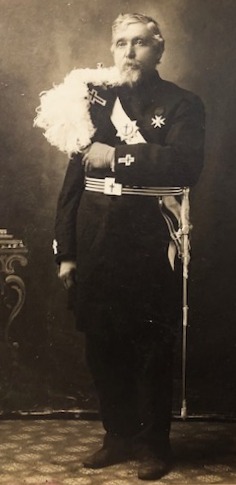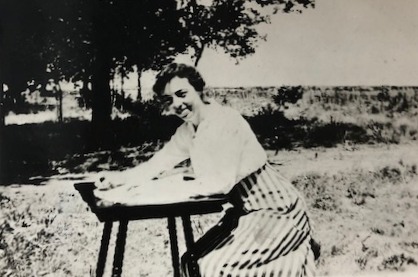There is no better time than Kearny County Fair week to learn more about Francis Livingston Pierce, the first treasurer of the Kearny County Fair Association. Known to many as Frank, F.L. Pierce was 100 years old when he died in 1947 and was considered by many to be the authority on Kearny County history as he had been around for most of it.
Pierce arrived here by covered wagon in 1879. He was born in Connecticut of honored New England ancestry, and his family lineage traced directly back to five of the 100 people aboard the Mayflower at Plymouth Rock, among them Miles Standish and John Alden. Pierce’s parents, Hezekiah and Julia Wilson Pierce, later moved to Illinois where Frank acquired his preliminary education. The family then went to Iowa in 1864, and F.L. completed his studies at Grinnell College. He engaged in farming, taught school a number of terms, and became active in public life. He served two years as the auditor of Powesheik County, Iowa and filled various township offices.
While in Iowa, Frank married Carolina Virginia Gray-McClellan, daughter of Major General Francis Gray and Sarah Roseberry Gray of Pennsylvania. It was the second marriage for Carolina who had divorced her first husband, James McClellan, with whom she had two children. Carolina and James’ daughter, Virginia Bell, died giving birth to her first child, and their son, Francis Gray, died at the age of 10. Frank Pierce and Carolina also had a son and a daughter. They named their son “Francis Gray” like his older half-sibling, but he had no better fate. The boy died before the age of one. Frank and Callie’s daughter, Virginia Pierce Hicks, was the third girl born in Kearny County and lived a long and industrious life. Sharing her father’s love for history, she became the first president of the Kearny County Historical Society.
When coming to Lakin, Frank Pierce filed homestead and timber claims just west of Lakin and planted a grove of trees where the first Kearny County Fairground was located. Pierce had the distinction of being the first farmer in Kearny County to fence his property. Paying 35 cents each for oak posts and 12.5 cents a pound for wire, he fenced a whole section of land. He was the first to introduce alfalfa into this section of country and made a specialty of raising alfalfa, cattle and horses. Pierce engaged in the real estate business for a while to sell railroad lands, setting up shop on Lakin’s Front Street first with C.O. Chapman and later with C.H. Longstreth. As justice of the peace in 1880, he solemnized the first weddings in this part of the country and also served three terms as county clerk. F.L. was identified with most civic movements in the early history of Kearny County and was a member of several fraternal organizations including Masons, Odd Fellows, Knights of Pythias, Woodmen of the World and others. He was the first Knight Templar to reside in Lakin and a charter member of the local Masons. Pierce served 45 years as the secretary of Emerald Lodge #289 garnering him recognition for the longest continuous service in the state of Kansas. He was instrumental in organizing not only the Kearny County Fair Association but also the Kearny County Old Settlers Association of which he served 17 years as secretary.
Many of the early county newspapers that were digitalized by the Kansas State Historical Society were those belonging to Francis L. Pierce, and much is written about his experiences in the first volume of our county history. In the Standard History of Kansas and Kansans, Pierce was spoken of as being distinguished not only for being a pioneer settler of this county but also for the prominence he attained in literary, political and fraternal circles. Francis L. Pierce died February 22, 1947.
Like her husband, Carolina Pierce took an active part in the transactions of the county, and she was one of the main characters in Chantilly’s battle for the county seat. She was an excellent horseback rider. Along with her sister, Mrs. George Garrettson, and niece, Ella Garrettson, Callie started the Double PL Bar Cattle Company running over 500 head of cattle. Their successful cow camp was located on sec. 36-22-37 north of Lakin. Then came the blizzard of 1886, and the women lost a large percentage of their herd like so many ranchers did. Mrs. Pierce offered 80 acres of cow camp land to locate the proposed county seat. Originally known as Myton, the site was then renamed Chantilly. Carolina helped make the first flag that was used at Lakin as well as the first one at Chantilly. She was one of the charter members of the Order of Eastern Star and served as the chapter’s first secretary. She was also a Rebekah and a member of the Old Settler’s Organization. In 1889, Callie became afflicted with an abscess and consulted the best surgeons of western Kansas but found no relief. She went to Chicago in June of 1889 to have the abscess removed and came through the severe operation but never fully recovered. Carolina Virginia Pierce was an invalid for the last few years of her life, passing away in 1908 at the age of 64.
Kearny Countians owe the F.L. Pierce family a debt of gratitude not only for what they did for the county in those early years but also for helping preserve county history. The Museum has several photographs, archives and artifacts which belonged to the family and were donated by Virginia Pierce Hicks and her daughter, Virginia Womble. These items give us a glimpse into the lives of not only these important pioneers but also the many others who saw the potential in the rugged, undeveloped prairie of Kearny County.




SOURCES: Diggin’ Up Bones by Betty Barnes; History of Kansas and Kansans by William E. Connelley; History of Kearny County Vol. I; and Museum archives.
